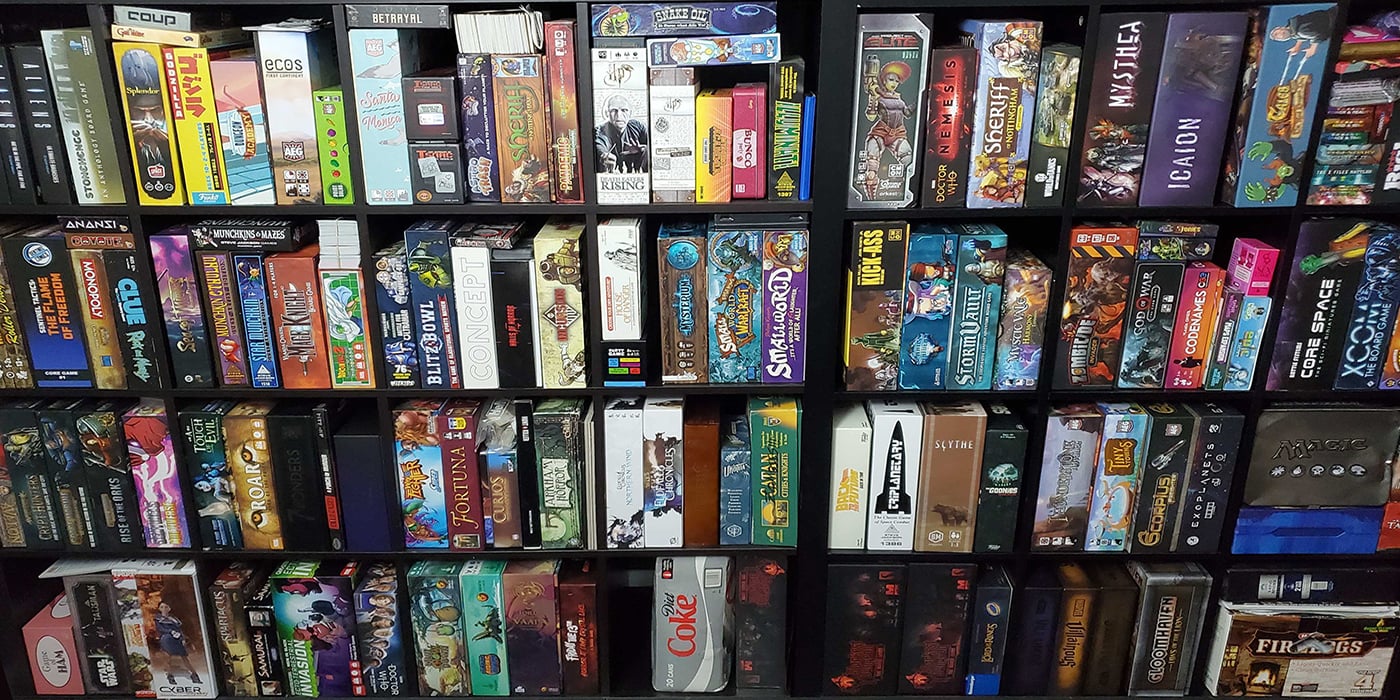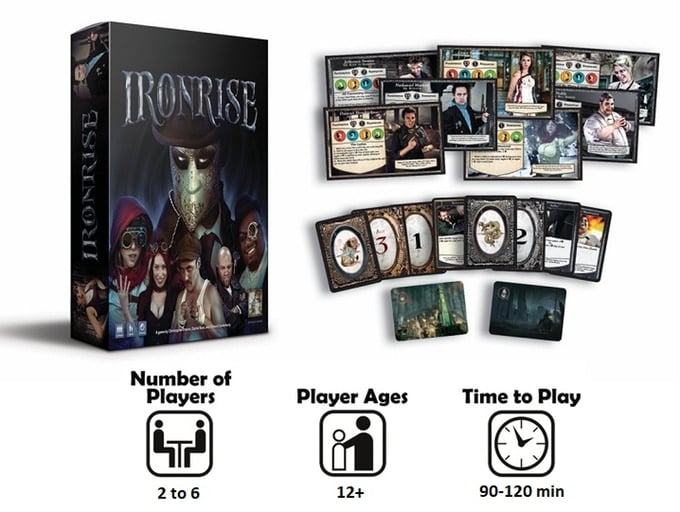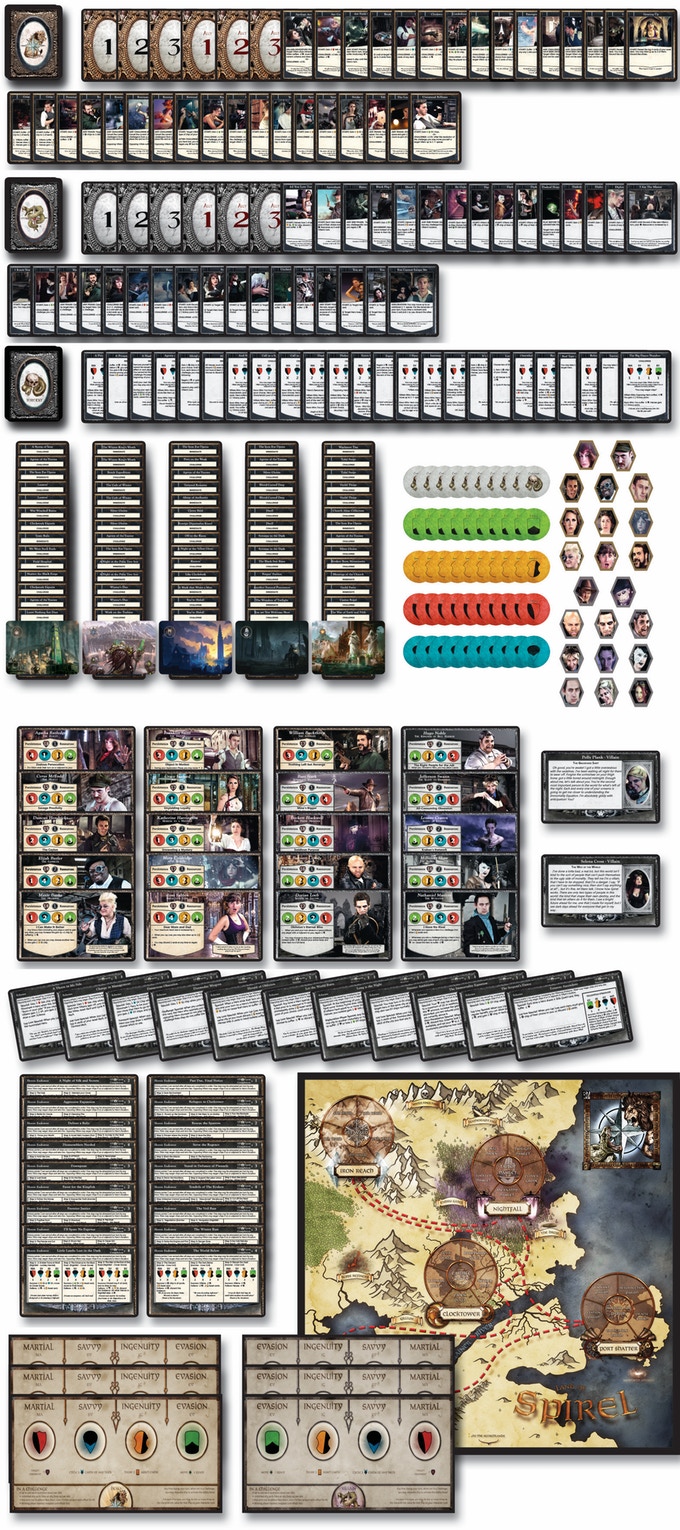Tabletop Spotlight: Ironrise First Impressions

Let’s take a quick look at Ironrise, an adventure board game currently on Kickstarter.
Several weeks back, a friend of mine told me about a unique competitive board game he had a chance to play at a convention earlier this year. The game is called Ironrise, and it’s been in development for four years by some old acquaintances of his. He managed to get me in touch with them, and they were generous enough to send an early prototype of the game to coincide with their Kickstarter campaign. Since this is a prototype then some things are subject to change, but after playing a few rounds I can say that Ironrise is an interesting take on narrative-driven adventure games that’s definitely worth checking out for yourself.
Ironrise is a team-based, asymmetrical adventure game of heroes vs. villains that supports up to six players. The games I played were 2v2, and we set the Victory Point cap at eight to keep it manageable as we learned how to play. The 2v2, 8 VP mode took us over two hours for the first game, but it was closer to the suggested play time of 90 minutes once we played again.
Players start by dividing themselves up into the Hero or Villain team, and then choose a character to play as. Each team has 11 characters, and they all have a unique set of abilities and starting resources. Here’s an example of a character stat board below:
Persistence is the character’s health, which is straightforward enough. Killing a character grants your team 2VP, but there’s no player elimination in Ironrise. If you die, then you just roll up a new character. The four colored circles represent the four resource chips in the game: Martial (MA, red), Savvy (SV, blue), Ingenuity (IG, orange), and Evasion (EV, green). The numbers on the circle represent your starting resources, and also the limit on how many of that resource you can spend a turn. You can spend MA to deal one damage to an opponent, SV to cycle (Look at, then rearrange) the top three cards of any deck, IG to draw two cards from your team’s Asset Deck, and EV to move one space on the board. You can do this at any time during your turn while not in a challenge. The max you can have of any resource is six, and they have other uses I’ll get to later.
In addition to the four types of chips, your other resources come in the form of Asset cards. Each team has a deck of these cards, and their function can vary greatly. The cards with numbers are used in the challenge portion of the game. Others will represent an action or a piece of equipment. The ones that say Start can be played at the beginning of your turn, while the ones that say Challenge have an effect that only triggers when revealed during a challenge. Quite a few cards will have both a Start and Challenge effect, ensuring that you’ll usually have quite a few options open to you. You can play up to three cards with Start effects at the beginning of your turn. Yet more cards might have some sort of interrupt effect that are played in response to an opponent’s actions.
Besides killing your rivals, the way teams score VP are actually quite different. The hero team draws a set of Endeavors at the start of the game. In the 2v2 format we played this meant three Endeavors, but in a 3v3 game they’ll have access to four. The Endeavors are essentially multi-staged quests that require the heroes to reach a certain location on the map and perform a challenge. Many of the Endeavors have two or three steps, but there are a few easy ones that are only worth 1VP that have just a single stage. These are the primary means of scoring VP for the heroes, and any hero can complete any stage of an Endeavor, so long as they are in the right location, but each stage must be completed in order. Alternatively, each city has a deck of side quests. Heroes will have the chance to complete a side quest on each of their turns while in the city, and the team will score 1VP for every three completed side quests in that location.
The villains instead draw Schemes before the game starts. Unlike Endeavors, Schemes are tied to the player that drew them. Schemes have less steps to complete and generally give you resources and bonuses when you draw it. They also have other effects that trigger when you attempt your Scheme. Schemes are generally worth less VP than Endeavors, but because they feature fewer steps they usually don’t take as long to complete. This system of Schemes and Endeavors means that the heroes have more chances to score VP and tend to have turns where they’ll score two or three at a time, while the villains will steadily gain them throughout the game. The villains also have more ways to directly attack and sabotage the heroes’ efforts.
Once everyone has their characters and Endeavors/Schemes, each player draws six cards from their team’s Asset deck and places a little character standee on the board. The game board has five cities, each of which is divided into five locations. Your starting location is dictated by the Endeavors/Schemes you drew. Heroes can choose to start at any of their Endeavors’ start locations, while the villains’ Schemes will say where that player starts.
Ironrise features an alternating turn sequence that generally breaks down to Hero-Villain-Hero-Villain until everyone has had a chance to go, as opposed to all players on a team activating at once like many other team-based games. As with many things in Ironrise, the hero and villain turn phases are subtly different. Every turn starts with the player drawing Asset cards before playing up to three of them, and then moving one space on the board. Now the next two steps are where things change depending on if you are a hero or villain.
As a hero, you now have a chance to do a side quest. This involves flipping the top card of that city’s deck and resolving the effects. These side quests might just be an effect that is immediately resolved, or they could initiate a challenge. The interesting part is that some of these immediate effect side quests are purely negative. Sometimes you might want to skip doing a side quest to avoid a challenge or one of these potential negative effects, but at the same time you are missing out on potential VP.
Villains don’t do side quests. Instead, they have the Torment deck. Like side quests, Torment cards might have an immediate effect, or initiate a challenge targeting a hero of your choice. These Torment cards often represent direct attacks on heroes, and will do things like deal damage, steal resources, discard Asset cards, or move the hero to another location on the board. After any side quests or torments have been resolved, the player can then choose to attempt their Endeavor or Scheme.
I’ve brought up challenges throughout this article, so it’s probably about time I described just what a challenge actually is. A challenge is essentially a 1v1 duel of wits and bluffs between a hero and a villain. When a hero begins an Endeavor/side quest, or a villain starts a Scheme, the opposing team will nominate a player to fight them in a challenge. Challenges initiated by Torment cards are unique because the villain that plays them gets to directly target a hero and force them into the challenge. Here’s an example of what a challenge looks like, as drawn from the Torment deck:
You’ll see that it has a picture of all four resource types. The MA and SV slots have an X, while the IG and EV ones have a 1 and 3, respectively. This means that both players will be fighting to win in just those two slots, and the numbers represent the difficulty of the challenge. A difficulty of 1 IG and 3 EV means that the villain will start with that many points in those slots. Here’s a picture of a challenge set up:
Players will alternate placing a card face-down in the relevant slots. You can only place one card face-down in each slot, but you could also choose not to place a card at all. The black number cards will add that many points to that slot in the final reveal. Cards with a Challenge effect will trigger said effect upon being revealed. Alternatively, you can easily bluff an opponent by putting a card that does nothing in the slot. It’s all up to you and what you think the best move is based on your current resources and position. The red number cards, called Ally cards, can be played face-up in a slot by one of your teammates. There are no restrictions on how many Ally cards can be played, but because they are played face-up that means that your opponent will know what they are. The overall goal of a challenge is to get a higher total number in a slot to “win” it, and to win more slots than your opponent. Each challenge will have rules on how to break ties.
Once cards have been placed, players will have a chance to wager chips. There’s lots of restrictions on wagering based on the challenge’s rules, so make sure you read them carefully. If you are able to wager, then you can choose to place chips from the relevant slot in front of you. Each chip will add 1 to the final total. Again, using the above example, since this is an IG/EV challenge then only IG and EV chips can be wagered. However, each character has a Resource stat that allows them to use chips from other stats during challenges. For example, a character with a Resource of 2 can take up to two chips from MA or SV and use them in my example challenge.
After placing cards and wagering, players will reveal their cards and calculate the results. In my example challenge, the hero wagered three chips in EV, plus a 3 card, and a 2 card and one chip in IG. The villain played a 2 in EV with one chip. The IG slot was actually a bluff. The villain wagered one chip to set up the bluff, and the card in the slot, Long Reach, had no value as an IG card. Instead, the card gave him +2 EV. Once you add in the difficulty chips, the villain had only 2 in IG, which is less than the hero’s 3 total. However, the villain’s EV total was 8 between the Long Reach card, the 2 card, the chip, and the 3 difficulty rating. This brings the challenge to a tie, but since villains win ties in this particular challenge, the hero loses and suffers the consequences.
The system is a little hard to explain in text, so I’d recommend reading the rules yourself and watching some of the tutorial videos on the Kickstarter page. Once you get the hang of the mechanics though, Ironrise is actually fairly straightforward and easy to play. The challenges are a really unique way of resolving combat in a board game of this style, and rely on a mix of bluffing, strategy, resource management, risk vs. reward, and coordination with your team.
Based on my (admittedly limited) play experience with Ironrise thus far, my only real complaints are with the materials used in the components. This is an early prototype, so these issues are all subject to change, but the cardboard used for the various chips and player standees weren’t especially sturdy. Likewise, I wish the cards were a bit thicker, because in their current state they feel pretty flimsy. The game also uses standard d20s instead of spindowns for tracking health and VP, a small annoyance that could be improved before release. That said, most of these issues are addressed as potential stretch goals in the campaign, so I hope they can hit those goals before the Kickstarter ends.
The actual presentation is pretty nice though. The game features a strange mix of traditional artwork and live actors portraying all the characters. From what I’ve heard, all the characters are people from the dev team and local cosplay groups dressed up in steampunk attire. Some of the pictures are a bit cheesy, but the use of actors in costumes does give the game a certain level of charm.
Another thing I’d like to address is that the character sheets and Schemes/Endeavors are all double-sided. The gameplay-relevant stuff is all on the front, while the back contains fluff like lore and bios. While that’s a nice touch, it does make randomization a little more tricky, especially once you’ve played enough games to start remembering the titles and names. Unfortunately, I’m not entirely sure how they could fix that issue given the way the cards are formatted already.
In its current form, Ironrise is a solid adventure game that’s not quite like anything else I’ve ever played. The mechanics are a bit confusing in places at first, but once you start playing it’s easy to get the hang of. The challenge system is particularly interesting, and offers a very different approach to confrontation mechanics than your typical dice-driven system. It’s a bit rough around the edges, as you might expect from the first project by a small team, but my group enjoyed it enough that I’ll have to make sure to bring it along to our regular board game sessions in the future for more playthroughs. You can currently grab a copy of Ironrise on Kickstarter for $49. By the time you read this article, you should still have about two weeks left to pledge.
Ironrise
~Does Ironrise look like a game that interests you?















